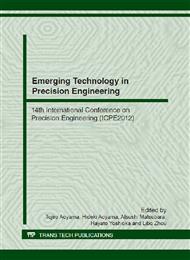p.627
p.633
p.639
p.645
p.650
p.656
p.662
p.668
p.674
A Micro-Stage for Linear-Rotary Positioning
Abstract:
In this paper, a novel Z-θZ micro-stage is designed and constructed by utilizing an impact friction drive. The stage is configured by two driving units, a moving element and a stage base. Each driving unit consists of two PZTs and a friction element. One end of each PZT is fixed on the stage base, and the other end is attached on a permanent magnet as the friction element. The moving element, which is a steel cylinder, is supported and moved by the friction element. Magnetic force generated by permanent magnet is utilized to stabilize the driving condition between the moving element and the friction element for the friction drive. The size of the stage is less than 1 cm3. The stroke and the maximum speed of the stage in the Z-direction are 3.8 mm, 5.7 mm/s, respectively. The stroke in the θZ-direction is unlimited and the maximum rotational velocity is 26 rpm.
Info:
Periodical:
Pages:
650-655
Citation:
Online since:
November 2012
Authors:
Price:
Сopyright:
© 2012 Trans Tech Publications Ltd. All Rights Reserved
Share:
Citation:


